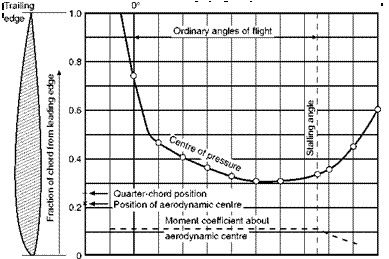The centre of pressure and moment coefficient
Lastly, let us examine the curves (Fig. 3.17, overleaf) which show how the centre of pressure moves, and what happens to the pitching moment coefficient, as the angle of attack is increased.
The centre of pressure curve merely confirms what we have already learnt about the movement of the centre of pressure on an ordinary aerofoil. After having been a long way back at negative angles, at 0° it is about 0.70 of the chord from the leading edge, at 4° it is 0.40 of the chord back, and at 12° 0.30 of the chord; in other words, the centre of pressure gradually moves forward as the angle is increased over the ordinary angles of flight; and this tends towards instability. After 12° it begins to move back again, but this is not of great importance since these angles are not often used in flight.
It is easy to understand the effect of the movement of the centre of pressure, and for that reason it has perhaps been given more emphasis in this book than it would be in more advanced books on the subject.
It is important to remember that the pitching moment, and its coefficient, depend not only on the lift (or more correctly on the resultant force) and on
 |
Fig 3.17 Centre of pressure and moment coefficient curves
the position of the centre of pressure, but also on the point about which we are considering the moment – which we shall call the reference point. There is, of course, no moment about the centre of pressure itself – that, after all, is the meaning of centre of pressure – but, as we have seen, the centre of pressure is not a fixed point. If we take as our point of reference some fixed point on the chord we shall find that the pitching moment – which was already slightly nose-down (i. e. slightly negative) at the angle of zero lift – increases or decreases as near as matters in proportion to the angle of attack, i. e. the graph is a straight line, like that of the lift coefficient, over the ordinary angles of flight. About the leading edge, for instance, it becomes more and more nose – down as the angle is increased; but about a point near the trailing edge, although starting at the same slightly nose-down moment at zero lift, it becomes less nose-down, and finally nose-up, with increase of angle (Fig. 3.18).
The reader may be surprised at the increasing nose-down moment about the leading edge, because is not the centre of pressure moving forward? Yes, but the movement is small and the increasing lift has more effect on the pitching moment. The intelligent reader may be even more surprised to hear that an increasing nose-down tendency is a requirement for the pitching stability of the aircraft, for have we not said that the movement of the centre of pressure was an unstable one? Yes, this is a surprising subject, but the answer to the apparent paradox emphasises once again the importance of the point of reference; in considering the stability of the whole aircraft our point of reference must be the centre of gravity, and the centre of gravity is always, or nearly
|
|
Fig 3.18 Moment coefficient about different reference points
always, behind the leading edge of the wing, so the change of pitching moment with angle of attack is more like that about the trailing edge – which is definitely unstable.












